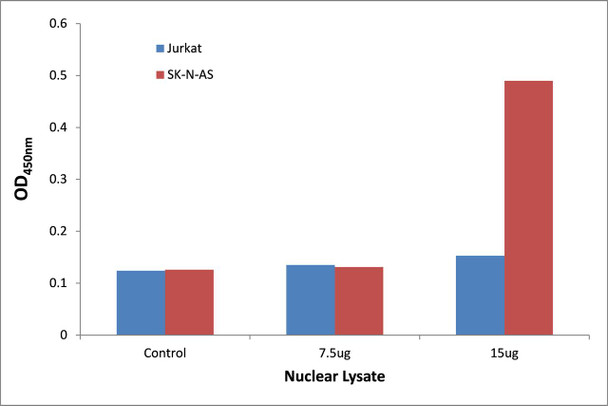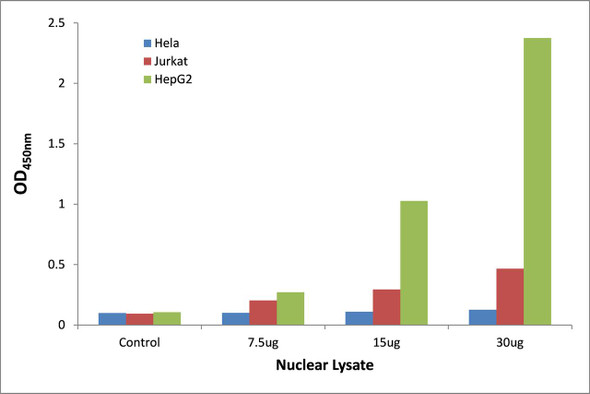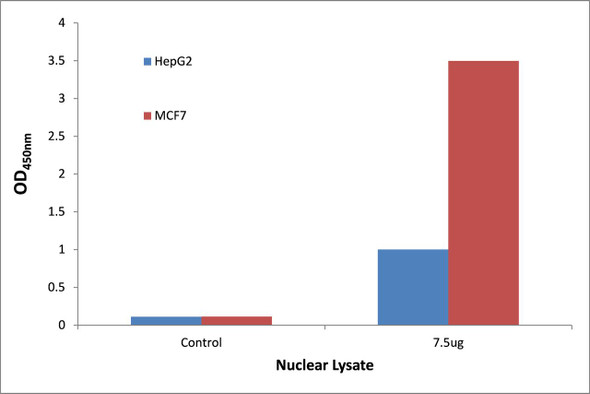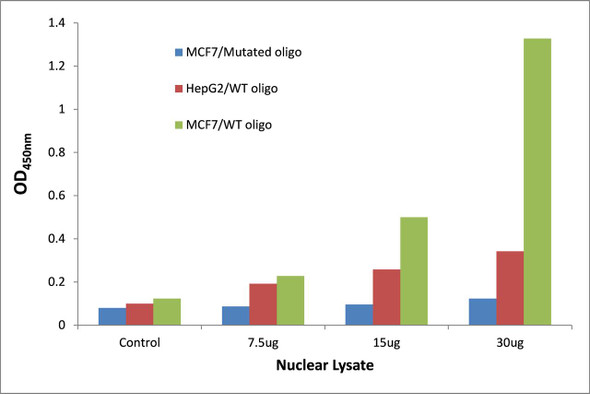Description
system_update_altDatasheet
| Product Name: | Maf Transcription Factor Activity Assay |
| Product Code: | TFAB00205 |
| Target: | Maf |
| Reactivity: | Human, Mouse, Rat |
| Sample Types: | Nuclear or cell lysates |
The Assay Genie Maf transcription factor activity assay allows for the detection and qualitative analysis of endogenous levels of activated transcription factors in a variety of nuclear and cell lysates
Assay Genie ELISA kits are designed to significantly reduce experiment time and ensure sensitivity and flexibility for high-throughput screening.
| Assay Time: | 4.5 hours |
| Detection Method: | Colorimetric 450 nm |
| Size: | 12 x 8-Well Microstrips |
| Storage: | 4°C for 6 months |
| UniProt Protein Function: | MAF: Acts as a transcriptional activator or repressor. Involved in embryonic lens fiber cell development. Recruits the transcriptional coactivators CREBBP and/or EP300 to crystallin promoters leading to up-regulation of crystallin gene during lens fiber cell differentiation. Activates the expression of IL4 in T helper 2 (Th2) cells. Increases T-cell susceptibility to apoptosis by interacting with MYB and decreasing BCL2 expression. Together with PAX6, transactivates strongly the glucagon gene promoter through the G1 element. Activates transcription of the CD13 proximal promoter in endothelial cells. Represses transcription of the CD13 promoter in early stages of myelopoiesis by affecting the ETS1 and MYB cooperative interaction. Involved in the initial chondrocyte terminal differentiation and the disappearance of hypertrophic chondrocytes during endochondral bone development. Binds to the sequence 5'-[GT]G[GC]N[GT]NCTCAGNN-3' in the L7 promoter. Binds to the T-MARE (Maf response element) sites of lens-specific alpha- and beta-crystallin gene promoters. Binds element G1 on the glucagon promoter. Binds an AT-rich region adjacent to the TGC motif (atypical Maf response element) in the CD13 proximal promoter in endothelial cells. When overexpressed, represses anti-oxidant response element (ARE)- mediated transcription. Involved either as an oncogene or as a tumor suppressor, depending on the cell context. Binds to the ARE sites of detoxifying enzyme gene promoters. Homodimer or heterodimer with other bHLH-Zip transcription factors. Binds DNA as a homodimer or as a heterodimer. Heterotetramer of two MAF and two USF2. Interacts with PAX6; the interaction is direct. Interacts with MYB; interaction takes place weakly in normal T-cells and increases in T-cells following stimulation through the TCR engagement. Interacts with MYB; the ternary complex formed with MYB and the CD13 promoter is regulated in response to differentiating signals. Interacts with USF2; the interaction inhibits its DNA-binding activity on the L7 promoter. Interacts with CREBBP, EP300 and ETS1. Up-regulated with tert-butyl hydroquinone (t-BHQ). Expressed in endothelial cells. Belongs to the bZIP family. Maf subfamily. 2 isoforms of the human protein are produced by alternative splicing. |
| UniProt Protein Details: | Protein type:Transcription factor; Cell development/differentiation; DNA-binding; Tumor suppressor; Oncoprotein Chromosomal Location of Human Ortholog: 16q22-q23 Cellular Component: chromatin; nucleus Molecular Function:protein binding Biological Process: regulation of transcription from RNA polymerase II promoter Disease: Ayme-gripp Syndrome; Cataract 21, Multiple Types |
| NCBI Summary: | The protein encoded by this gene is a DNA-binding, leucine zipper-containing transcription factor that acts as a homodimer or as a heterodimer. Depending on the binding site and binding partner, the encoded protein can be a transcriptional activator or repressor. This protein plays a role in the regulation of several cellular processes, including embryonic lens fiber cell development, increased T-cell susceptibility to apoptosis, and chondrocyte terminal differentiation. Defects in this gene are a cause of juvenile-onset pulverulent cataract as well as congenital cerulean cataract 4 (CCA4). Two transcript variants encoding different isoforms have been found for this gene. [provided by RefSeq, Jan 2010] |
| UniProt Code: | O75444 |
| NCBI GenInfo Identifier: | 223590080 |
| NCBI Gene ID: | 4094 |
| NCBI Accession: | O75444.2 |
| UniProt Secondary Accession: | O75444,Q66I47, Q9UP93, |
| UniProt Related Accession: | O75444 |
| Molecular Weight: | 41,961 Da |
| NCBI Full Name: | Transcription factor Maf |
| NCBI Synonym Full Names: | MAF bZIP transcription factor |
| NCBI Official Symbol: | MAF |
| NCBI Official Synonym Symbols: | CCA4; AYGRP; c-MAF; CTRCT21 |
| NCBI Protein Information: | transcription factor Maf |
| UniProt Protein Name: | Transcription factor Maf |
| UniProt Synonym Protein Names: | Proto-oncogene c-Maf; V-maf musculoaponeurotic fibrosarcoma oncogene homolog |
| Protein Family: | Maf-like protein |
| UniProt Gene Name: | MAF |
| UniProt Entry Name: | MAF_HUMAN |






